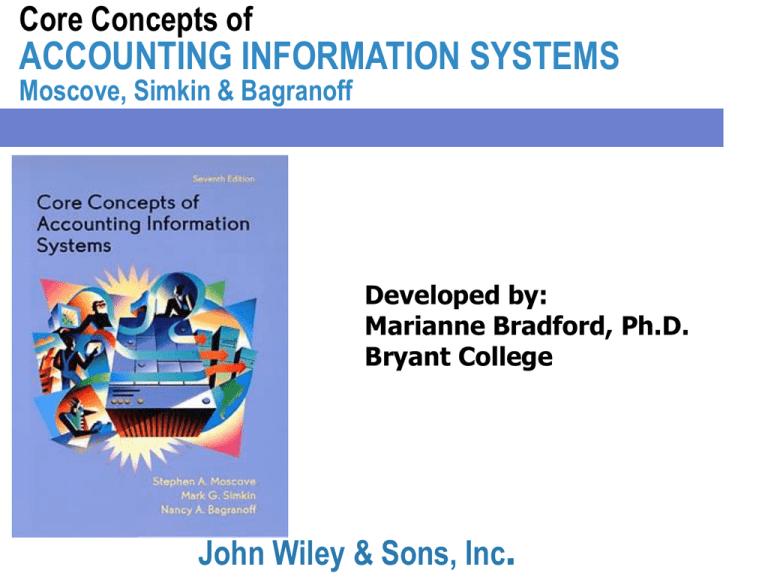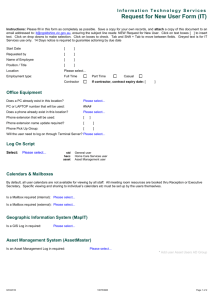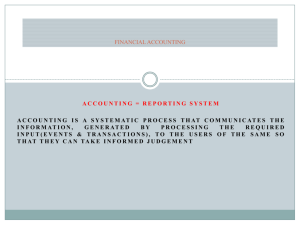
Core Concepts of
ACCOUNTING INFORMATION SYSTEMS
Moscove, Simkin & Bagranoff
Developed by:
Marianne Bradford, Ph.D.
Bryant College
John Wiley & Sons, Inc.
Chapter 4
Transaction Processing: Fundamentals and
Major Processing Cycles
• Introduction
• Transaction Processing Fundamentals
• Collecting and Reporting Accounting
Information
• Transaction Processing Cycles
Introduction
• AISs depend on the flow of data through
various organizational subsystems.
• Effective transaction processing systems ensure
capture of appropriate data and
accurate information reporting.
• Transaction processing cycles organize
transactions related to an
organization’s business processes.
Transaction Processing
Fundamentals
• The accounting cycle begins when
accounting personnel analyze a
transaction from a source document.
• A source document is a piece of paper or
electronic form that records a business
activity such as the purchase or sale of
goods.
Journals
• Accounting personnel record transactions in a journal.
• The journal is a chronological record of business events
by account.
• A journal may be a general journal or a special journal.
– A general journal allows any type of accounting
transaction to be recorded.
– A special journal captures specific types
of transactions.
Ledgers
• A ledger may be a general ledger or a
subsidiary ledger.
– A general ledger is a collection of detailed monetary
information about an organization’s assets,
liabilities, revenues, and expenses.
– A subsidiary ledger contains detailed records
pertaining to a particular account in
the general ledger.
Trial Balances
• Once an AIS records journal entries and posts them
to the general ledger, the system can create a trial
balance.
• Three end of period trial balances are needed:
– A preadjusting trial balance after all entries have
been posted;
– An adjusted trial balance after adjustments have
been recorded and posted;
– A postclosing trial balance after temporary
accounts have closing entries have been recorded
and posted.
Financial Statements
• Financial statements are the primary
output of a financial accounting system.
• These statements include:
–
–
–
–
Income Statement
Statement of Owners Equity
Balance Sheet
Statement of Cash Flows
Coding Systems
•
•
•
AISs depend on coding to record, store,
classify and retrieve financial data.
Computer systems most often use numeric or
alphanumeric codes for processing accounting
transactions.
Purposes of coding:
1. Uniquely identify transactions
and accounts
2. Compress data
3. Aid in classification process
4. Convey special meanings
Types of Codes
• Mnemonic Codes give visible clues concerning the
objects they represent.
• Sequence Codes assign numbers or letters in
consecutive order.
• Block Codes are sequential codes in which specific
blocks of numbers are reserved for particular uses.
• Group Codes reveal two or more
dimensions or facets pertaining to
an object.
Design Considerations
in Coding
• Codes should serve some useful purpose.
• Codes should be consistent.
• Codes should be standardized throughout
the organization.
• Codes should plan for future
expansion.
Collecting and Reporting
Accounting Information
•
•
Design of an effective AIS begins by
considering outputs from the system.
Outputs of an AIS include:
1.
2.
3.
4.
reports to management
reports to investors and creditors
files that retain transaction data
files that retain current
data about accounts
Considerations in
Report Design
• Reports that only list exceptional conditions are
exception reports.
• Reports should be useful to managerial
decision-making without creating information
overload.
• Format should be convenient, contain
fundamental identification, and
be consistent.
Transaction Processing
Cycles
• An AIS consists of one or more
transaction processing cycles or
applications.
• These cycles group transactions related to
an organization’s business processes.
• The objective of grouping like
transactions is to simplify
information processing.
The Revenue Cycle
• The revenue cycle begins with a customer order
for goods or services and ends with the
collection of cash from the customer.
• The primary objective is to achieve
timely and efficient revenue collection.
• An organization that generates revenues,
but fails to collect these revenues on a timely
basis, may find itself in a position where it
cannot pay its bills.
Objectives of the Revenue
Cycle
• Tracking sales of goods and/or services to
customers.
• Filling customer orders.
• Billing customers for goods and services
• Collecting payment for goods and
services.
• Forecasting sales and cash receipts.
Inputs to the Revenue Cycle
• Sales Order - prenumbered and usually prepared in
multiple copies; used to prepare sales invoice
• Sales Invoice - prepared after shipment of goods or
providing of a service
• Remittance Advice - serve as source document for
credits to accounts receivable
• Shipping Notice - warehouse prepares after goods are
released for shipment
• Debit/Credit memo - issued for sales returns and
allowances; debit memos increase amount customer
owes
Outputs of the Revenue Cycle
• Financial Statement Information
• Customer Billing Statement - includes
customer account activity such as sales,
returns, and cash receipts
• Accounts Receivable Aging Report - contains
data concerning the status of open
balances of all active credit
customers arranging the overdue
amounts by time periods
Outputs of the Revenue Cycle
• Bad Debt Report - customer accounts written off.
• Cash Receipts Forecast - all data gathered from
source documents in revenue transactions are
inputs to this forecast.
• Customer Listing - shows customer codes, contacts,
shipping and billing addresses, credit limits, and
billing terms.
• Sales Analysis Reports - captures detailed data
about each sale in order to monitor sales activities
and plan production and marketing efforts.
The Purchasing Cycle
• The purchasing cycle begins with a
request for goods or services and ends
with the payment of cash to the vendor.
• Purchase may be for either goods
or services and for cash or on
credit.
Objectives of the Purchasing
Cycle
• Tracking purchases of goods and/or services
from vendors
• Tracking amounts owed
• Maintaining vendor records
• Controlling inventory
• Making timely and accurate vendor payments
• Forecasting purchases and cash outflows
Inputs to the
Purchasing Cycle
• Purchase Requisition - shows items requested by stores
and may indicate the name of the vendor
• Purchase Order - based on purchase requisition but also
includes vendor information and payment terms
• Vendor Invoice - includes items shipped by vendors,
prices, shipping terms and discounts provided
• Receiving Report - reflects the count and condition of
received goods
• Bill of lading – accompanies the goods sent
• Packing slip – included in the merchandise package
• Debit/Credit Memoranda - debits or credits accounts
payable
Outputs of the
Purchasing Cycle
• Financial Statement Information
• Vendor Checks - should be supported by a voucher
and signed by a person designated by management
• Check Register - lists all checks issued for a
particular period
• Discrepancy Reports - used to identify any
differences among quantities on the purchase order,
receiving report, and vendor invoice
• Cash Requirements Forecast - predicts future
payments and payment dates by reference to
outstanding purchase order, unbilled receiving
reports and vendor invoices
The Resource
Management Cycle
• Organizations use resources to produce
goods or services sold to generate
revenues.
• Two other resources besides
inventory requiring attention
by an AIS are human resources
and fixed assets.
Human Resource
Management
• An organization’s human resource
management activity includes the personnel
function and the payroll function.
• The personnel function is responsible
for hiring employees and maintaining
personnel records.
• The payroll function is responsible
for maintaining the accounting
records related to employee
remuneration.
Objectives of Human
Resource Management
• Hiring, training, and employing workers
• Maintaining employee earnings records
• Complying with regulatory reporting
requirements
• Reporting on payroll
deductions
• Making timely and
accurate payments to
employees
• Providing an interface for
personnel and payroll activities
Inputs to Human
Resource Management
• Personnel Action Forms - document the hiring of
new employees or changes in employee status
• Time Sheets - used to track hours worked
• Payroll Deduction Forms - authorize the payroll
system to deduct amounts from gross pay for
items such as retirement, insurance, or union dues
• Tax Withholding Forms - authorize payroll to
reduce gross pay by the appropriate withholding
tax.
Outputs of Human
Resource Management
• Financial Statement Information
• Employee Listings - shows current employees and
may contain address and other demographic
information
• Paychecks - the final documents in the process;
subject to strict internal controls
• Check Registers - used to make journal entries for
salary and payroll tax expenses
Outputs of Human
Resource Management
• Deduction Reports - contain summaries of
deductions for employees as a group
• Tax (Regulatory) Reports - reports the
government requires for income tax, social
security tax, and unemployment tax
information
• Payroll Summaries - used by
management in analyzing
expenses
Fixed Asset Management
• Fixed assets are assets with usable lives of
more than one year.
• The objective of a fixed-asset
management system is to manage the
purchase, maintenance, valuation
and disposal of an organization’s
fixed assets.
Objectives of Fixed Asset
Management
•
•
•
•
Tracking purchases of fixed assets
Recording fixed asset maintenance
Valuing fixed assets
Allocating fixed asset costs
(recording depreciation)
• Tracking fixed asset disposals
Inputs to Fixed Asset
Management
•
•
•
•
Purchase Requisition
Receiving Reports
Supplier Invoices
Construction Work Orders - if the company
builds the asset
• Repairs and Maintenance Reports - notifies a
company’s AIS to update expense or asset
accounts for repairs and maintenance
• Fixed Asset Change Forms - used as the basis
for transferring fixed assets from one location
to another, retiring, selling or trading-in fixed
assets
Outputs of Fixed Asset
Management
• Financial Statement Information
• Fixed Asset Register - lists identification numbers
for each fixed asset and each assets location
• Depreciation Register - shows depreciation expense
and accumulated depreciation for each fixed asset
• Repair and Maintenance Reports - show the
current period’s repair and maintenance expenses
as well as each fixed asset’s repair and
maintenance history
• Retired Assets Report - shows all assets
disposed of during the accounting period
Copyright
Copyright 2001 John Wiley & Sons, Inc. All rights reserved.
Reproduction or translation of this work beyond that permitted in
Section 117 of the 1976 United States Copyright Act without the
express written permission of the copyright owner is unlawful.
Request for further information should be addressed to the
Permissions Department, John Wiley & Sons, Inc. The purchaser may
make backup copies for his/her own use only and not for distribution
or resale. The Publisher assumes no responsibility for errors,
omissions, or damages, caused by the use of these programs or from
the use of the information contained herein.
Chapter 4








